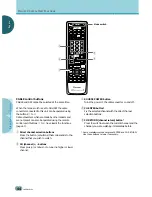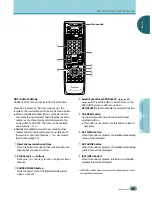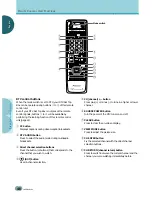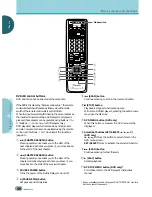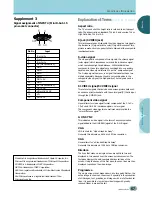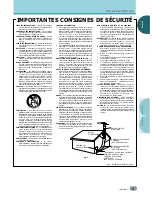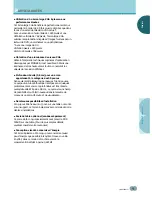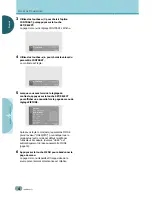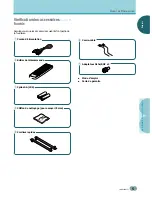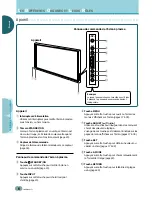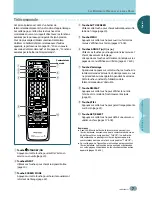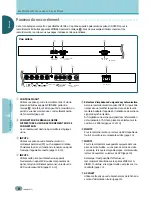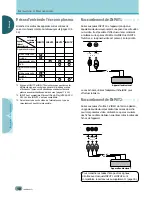
A
DDITIONAL
I
NFORMA
TION
○ ○ ○ ○ ○ ○ ○ ○ ○ ○ ○ ○ ○ ○ ○ ○ ○ ○ ○ ○ ○ ○ ○ ○ ○ ○ ○ ○ ○ ○ ○ ○ ○ ○ ○ ○ ○ ○ ○ ○ ○ ○ ○ ○ ○ ○ ○ ○ ○ ○ ○ ○ ○ ○ ○ ○ ○ ○ ○ ○ ○ ○
E
E
NGLISH
NGLISH
○○○○○○○○○○○○○○○○○○○○○○○○○○○○○○○○○○○○
○○○○○○○○○○○○○○○○○○○○○○○○○○○○○○○○○○○○○○○○○○○○○○○
<ARE1349> En
57
A
DDITIONAL
I
NFORMATION
○ ○ ○ ○ ○ ○ ○ ○ ○ ○ ○ ○ ○ ○ ○ ○ ○ ○ ○
Explanation of Terms
Aspect ratio
The TV screen’s width to height ratio is referred to as its aspect
ratio. The aspect ratio on standard TVs is 4:3 and on wide TVs or
High Definition TVs it is 16:9.
S jack (S VIDEO jack)
This jack separates and transmits the video signal as two signals;
the luminance (Y) signal and the color(C) signal. Because of this,
picture reproduction is superior to that obtained at the composite
input/output jacks.
S-video signal
The video signal is composed of two signals; the chroma signal
(color signal) which reproduces color and the luminance signal
which reproduces light and darkness. With standard video
components, these two signals are combined into one and are
handled as a video signal referred to as the “composite signal”.
The S-video signal, however, is a signal that handles these two
signals separately. Because they are not combined as in the
composite video signal, the high quality of both signals can be
retained.
S1 VIDEO signal/S2 VIDEO signal
This refers to signals that include wide screen picture data such
as squeeze or letterbox data with the color signal (C) that is input
through the S VIDEO jack.
Component video signal
General term for video signal format composed of the Y.C
B
.C
R
,
Y.P
B
.P
R
and Y.B-Y.R-Y luminance color signal.
The component video signal is sometimes simply called the
“color difference signal”.
G ON SYNC
This indicates a video signal in the form of a synchronization
signal added to the G (GREEN) signal of the R.G.B signal.
VGA
VGA is short for “Video Graphics Array”.
Generally this indicates a 640 dot x 480 line resolution.
XGA
General term for “eXtended Graphic Array”.
Generally this indicates a 1024 dot x 768 line resolution.
Interlace
The lines that make up a single screen are split into two and
displayed in two passes over the screen quick succession. The
first pass displays the odd numbered horizontal lines of the
screen. Using the decay of the first pass, the even lines are then
displayed to produce the video image.
Progressive
The single screen is not broken down into two parts. Rather, the
entire image is shown on the screen. Especially in the production
of still images, text, graphics, and images with a lot of horizontal
lines, it is possible to view a clear video image with greatly
reduced flicker in areas of detail.
Supplement 3
Signal assignment of INPUT 4 (Mini D-Sub 15
pin socket connector)
Input
1
2
3
4
5
6
7
8
9
10
11
12
13
14
15
R or C
R
/P
R
G or Y
B or C
B
/P
B
NC (No Connection)
GND
GND
GND
GND
DDC + 5V
GND
NC (No Connection)
DDC SDA
HD or H/V SYNC
VD
DDC SCL
5
1
15 11
6
10
Pin No.
Macintosh is a registered trademark of Apple Computer, Inc.
Microsoft is a registered trademark of Microsoft Corporation.
PC-9800 is a trademark of NEC Corporation.
NEC is a trademark of NEC Corporation.
VESA is a registered trademark of Video Electronics Standards
Association.
Sun Microsystems is a registered trademarks of Sun
Microsystems, Inc.


